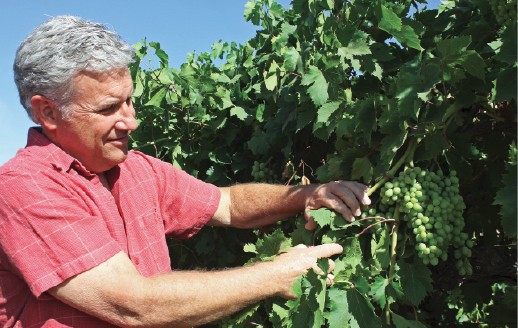CA Agriculture Leadership Transitions
CA Agricultural Leadership Transitions: Barry Bedwell to Head CALF, George Radanovich to Lead CFFA
By Patrick Cavanaugh, Farm News Director
There is a change in leadership at the Fresno-based California Fresh Fruit Association (CFFA), where Barry Bedwell has served as president for 13 years. The new president, as of August 1st, is former eight-term member of Congress for Mariposa County, George Radanovich, “and a five-year retiree in Mariposa, too,” said Radanovich.
“Don’t forget to add that,” he insisted. “Yes, the opportunity came up. My son King graduated from high school, and now he’s off to college at Ole Miss. This gives me the time to get back and start working on water and labor issues that I love—and being involved with the ag industry. The timing is perfect, and it’s a real exciting adventure for me.”

George Radanovich will head California Fresh Fruit Associaition
Radanovich served in Congress from 1995 to 2011, representing a big chunk of the Central Valley in California’s 19th District in the U.S. House of Representatives. While there, he served on the Committee on Energy and Commerce and its subcommittees: Communications, Technology and the Internet, Commerce, Trade and Consumer Protection (Ranking Member) and Oversight and Investigations. Radanovich also served as co-chair of the Water Caucus, Congressional Wine Caucus and Congressional Croatian Caucus, as well as being considered an agricultural expert in areas related to water supply and immigration reform.
Barry Bedwell will now assume presidency of the California Agricultural Leadership Foundation (CALF), a non-profit corporation committed to leadership training and transformational learning experiences in partnership with California Polytechnic State University (Cal Poly) in San Luis Obispo and Pomona; California State University, Fresno; and the University of California, Davis.
“I am excited about it,” Bedwell said. “I think it’s a great opportunity for myself and a chance to really take what I’ve learned over four plus decades in California agriculture and put it to good and practical use.”
Bedwell will be replacing Bob Gray at the Agricultural Leadership Foundation. “Bob Gray has done an absolutely fantastic job in really focusing the program more on leadership development,” noted Bedwell. “It is really doing personal coaching and working on leadership tendencies. When I was there thirty-four years ago in Class 13, the foundation tried to expose people in agriculture to things outside of the realm of agriculture; but now, they’ve taken it even a step further to say, ‘Here’s how to make you a better leader. Here is how to really strengthen your areas so that in the end, everyone coming out of this program will be a better person and representative for California agriculture.'”

Barry Bedwell Will lead the CA Ag Leadership Foundation
“The program has changed from 24 months down to 17 months, but it’s still a very valuable proposition,” noted Bedwell. “I think the estimated monetary value of what this means to the individuals involved is something like $50,000,” he said.
Bedwell brings to CALF a depth of experience in agriculture. “How do you develop the Leadership Program for maximum benefit?” asked Bedwell. “That’s where I think I can particularly help, knowing the issues that face California agriculture and what we have to deal with primarily in Sacramento. I think that will be a big help.”
Bedwell also emphasized the importance of keeping CALF alumni engaged. “With over 1300 graduates, this program is a powerful force out there,” he said. “We want to continue to build on what we have, and engagement with those alumni is critical, moving forward,” said Bedwell.
And perhaps certain alumni could be the new messengers to Sacramento. “What’s clear right now is we don’t necessarily have the right messengers. This Ag Overtime bill [AB-2757 Agricultural workers: wages, hours, and working conditions], which was reintroduced after failing in the Assembly a few weeks ago, has convinced me that although we went in and explained the negative impact it would have on employees, quite frankly, certain members did not believe us,” said Bedwell.
“We have to change the messenger, or the message gets lost sometimes,” Bedwell commented. “So that’s part of what we have to think about in looking at the future. We say the right things, but they are not getting through, so now we have to figure out how we get through,” Bedwell said.


















